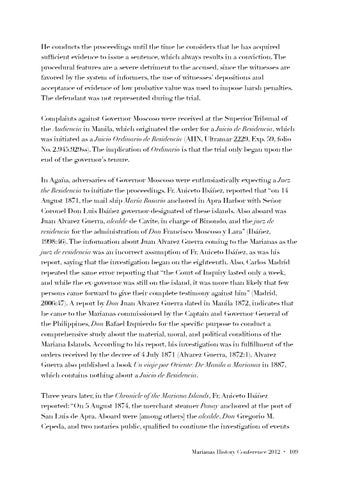He conducts the proceedings until the time he considers that he has acquired sufficient evidence to issue a sentence, which always results in a conviction. The procedural features are a severe detriment to the accused, since the witnesses are favored by the system of informers, the use of witnesses’ depositions and acceptance of evidence of low probative value was used to impose harsh penalties. The defendant was not represented during the trial. Complaints against Governor Moscoso were received at the Superior Tribunal of the Audiencia in Manila, which originated the order for a Juicio de Residencia, which was initiated as a Juicio Ordinario de Residencia (AHN, Ultramar 2229, Exp. 59, folio No. 2.945.929ss). The implication of Ordinario is that the trial only began upon the end of the governor’s tenure. In Agaña, adversaries of Governor Moscoso were enthusiastically expecting a Juez the Residencia to initiate the proceedings. Fr. Aniceto Ibáñez, reported that “on 14 August 1871, the mail ship María Rosario anchored in Apra Harbor with Señor Coronel Don Luis Ibáñez governor-designated of these islands. Also aboard was Juan Alvarez Guerra, alcalde de Cavite, in charge of Binondo, and the juez de residencia for the administration of Don Francisco Moscoso y Lara” (Ibáñez, 1998:46). The information about Juan Alvarez Guerra coming to the Marianas as the juez de residencia was an incorrect assumption of Fr. Aniceto Ibáñez, as was his report, saying that the investigation began on the eighteenth. Also, Carlos Madrid repeated the same error reporting that “the Court of Inquiry lasted only a week, and while the ex-governor was still on the island, it was more than likely that few persons came forward to give their complete testimony against him” (Madrid, 2006:47). A report by Don Juan Alvarez Guerra dated in Manila 1872, indicates that he came to the Marianas commissioned by the Captain and Governor General of the Philippines, Don Rafael Izquierdo for the specific purpose to conduct a comprehensive study about the material, moral, and political conditions of the Mariana Islands. According to his report, his investigation was in fulfillment of the orders received by the decree of 4 July 1871 (Alvarez Guerra, 1872:1). Alvarez Guerra also published a book Un viaje por Oriente: De Manila a Marianas in 1887, which contains nothing about a Juicio de Residencia. Three years later, in the Chronicle of the Mariana Islands, Fr. Aniceto Ibáñez reported: “On 5 August 1874, the merchant steamer Panay anchored at the port of San Luis de Apra. Aboard were [among others] the alcalde, Don Gregorio M. Cepeda, and two notaries public, qualified to continue the investigation of events
Marianas History Conference 2012 ・ 109
